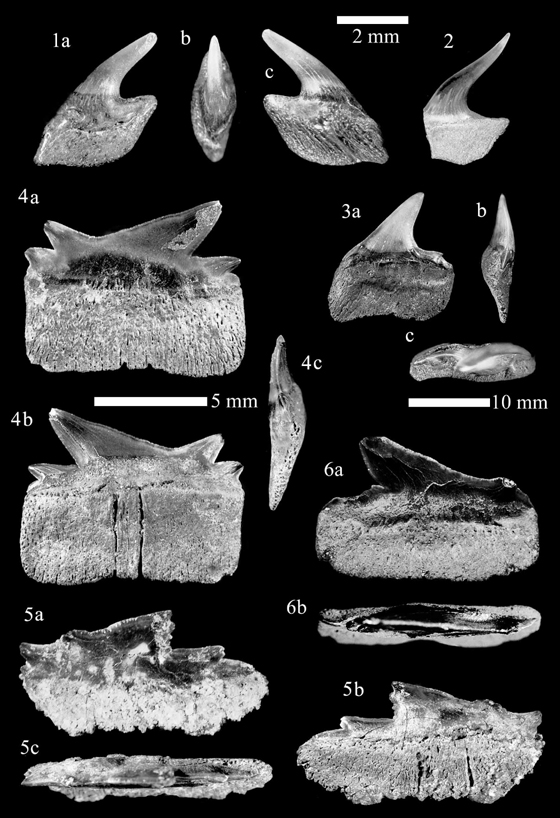
|

|
PALAEONTOS 20Price: non-members: 40 euros (plus postage) ; members: 35 euros (plus postage) Reinecke T., Louwye S., Havekost U. & Moths H., 2011, The elasmobranch fauna of the late Burdigalian, Miocene, at Werder-Uesen, Lower Saxony, Germany, and its relationships with Early Miocene faunas in the North Atlantic, Central Paratethys and Mediterranean. ISSN 1377-4654.(170 pages, 40 text-figures, 3 tables, 101 plates)Abstract: The Lower Mica Fine Sand (LMFS) Formation at Werder-Uesen, northwestern Lower Saxony, Germany, yields 40 shark and 12 batoid species, 13 of which are reported in open nomenclature. The recovered elasmobranch remains are mainly isolated teeth, and less commonly gill rakers, caudal spines, thorns, dermal denticles and vertebrae. The fauna is the richest thus far reported from shelf regions of the southern North Sea Basin and also one of the most diverse elasmobranch faunas collected from the Early and Middle Miocene of Europe. The sediments of the LMFS Formation sampled at Werder-Uesen represent the upper levels of the early Hemmoor regional stage ("Behrendorf substage") which corresponds to the middle and late Burdigalian. The dinoflagellate cyst assemblage recovered at Werder-Uesen correlates with the Cousteaudinium aubryae Biozone of Dybkja er & Piasecki (2010) which has a late Burdigalian age. Most shark and ray genera of the Werder-Uesen fauna, e.g. Carcharias, Chaenogaleus, Carcharhinus, Galeocerdo, Hemipristis, Paragaleus, Rhizoprionodon, Sphyrna, Aetobatus, Dasyatis, Rhinobatos, Rhynchobatus, Rostroraja and Taeniura, are closely related with present-day neritic and benthic taxa dwelling in warm-temperate and subtropical shelf seas. In addition, a small but significant elasmobranch assemblage indicative of pelagic, oceanic habitats (9 species of Isurus, Alopias, Megachasma, Prionace, Megascyliorhinus, Plinthicus) is present, whereas taxa living in present-day deepwaters of the oceans and continental slopes (Hexanchus, Echinorhinus, Iago) are very rarely encountered. 25 shark and 8 batoid taxa of the Werder-Uesen fauna entered the Miocene North Sea Basin for the first time. The prominent increase in species richness, which is known also for other groups of vertebrates and invertebrates in the early Hemmoor regional stage, likely results from the middle to late Burdigalian warming that passed into the Mid-Miocene climate optimum. The common presence of some species of Isurus and Alopias in the LMFS Formation, compared with their uncommonness or absence in Aquitanian to early Burdigalian sediments of the same region, supports the hypothesis, that a permanent marine connection became established in middle Burdigalian times between the southern North Sea and the warm-temperate eastern Atlantic. Interregional comparison shows a marked correspondence of shelf-related neritic and benthic taxa in boreal (North Sea), Mediterranean and central Paratethyan realms during the middle/late Burdigalian. This likely resulted from the shift and enlargement of warm-temperate/subtropical climate areas to northern latitudes which established similar thermophilic faunal assemblages by dispersion into the North Sea Basin via the eastern Atlantic. However, the lack of the present-day tropical/subtropical genera Ginglymostoma, Isogomphodon, Negaprion, Pseudocarcharias, Pteromylaeus, Rhinoptera and Pristis in the North Sea Basin and their partial presence in the Mediterranean Tethys and Central Paratethys indicates a faunal differentiation in the European Burdigalian which was probably governed by climatic factors. |
|
ORDER INFORMATION:please contact us at: palaeontos@gmail.com |
|